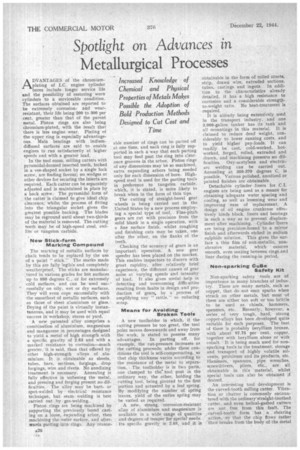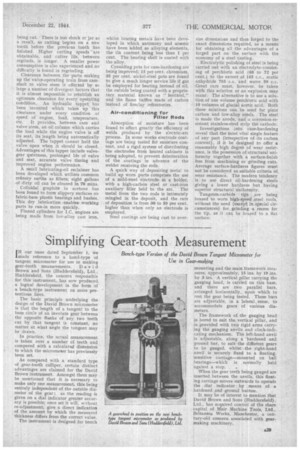Spotlight on Advances in
Page 28

Page 31

If you've noticed an error in this article please click here to report it so we can fix it.
Metallurgical Processes
Increased Knowledge of Chemical and Physical Properties of Metals Makes Possible the Adoption of Bold Production Methods Designed to Cut Cost and Time
ADVANTAGES of the chromiumplating of I.C. engine Cylinder bores include longer service life and the possibility of restoring worn cylinders to a serviceable condition. The surfaces obtained are reported to be extremely corrosionand wearresistant, their life being 200 to 300 per cent, greater than that of the parent metal. Piston rings are also being chromium-plated, with the result that there is less engine wear. Plating of the upper rina° is especially advantageous. Main bearings with indiumdiffused surfaces are said to enable engines to run satisfactorily at Isigher speeds and with a greater load.
In the tool room, milling cutters with pyramidal-formed inserted teeth, locked in a vee-shaped socket by a single lock screw, are finding favour; no wedges or other devices for securing the inserts are required. Each cutter can he separately adjusted and is maintained in place by a back screw. The pyramidal form of the cutter is claimed to give ideal chip clearance, whilst the process of fitting into the triangular socket gives the greatest possible backing. The blades may be reground until about two-thirds of the material is removed. The cutting teeth may be of high-speed steel, stellite or tungsten carbide.
New Stick-form Marking Compound
The marking of metallic surfaces by chalk tends to be replaced by the use of a paint " stick." The marks made by this are fully legible and completely weatherproof. The sticks are manufac,tured in various grades for hot surfaces up to 9.80 -degrees C., Or for extremely cold surfaces, and can be used suecessfully on oily, wet or dry surfaces. They will even cope successfully with the smoothest of metallic surfaces, such as those of sheet aluminium or glass. Drying of the paint is virtually instantaneous, and it may be used with equal success in workshop, stores or yard.
A new patented alloy comprises a combination of aluminium, magnesium and manganese in pereentages designed to yield a metal of high strength with a specific gravity of 2.63 and with a marked resistance to corrosion—much greater, it is said, than that offered by other high-strength alloys of aluminium. It is obtainable as sheets, tubes, bars, sections, forgings, drop forgings, wire and rivets. No anodizing treatment is necessary. Annealing is fully effective in softening the metal, and pressing and forging present no-difficulties. The alloy may be buttor spot-welded by electrical resistance technique, but seam welding is best carried out by gas-welding.
Piston rings are being machined by supporting the previously bored casting on a loose, expanding arbor, then machining the outer surface, and afterwards parting into rings. Any reason A26 able number of rings can be parted off at one time, and each ring is fully supported in such a way that each parting tool may feed past the ring into clearance grooves in the arbor. Piston rings of any dimensions may be so machined, extra expanding arbors being needed only for each dimension of bore, Highspeed steel is used for the parting tools in preference to tungsten carbide. which, it is stated, is mOre likely to break when in the form of thin tips. The cutting of straight-bevel gear wheels is being carried out in the .United States by a new process employing a special type of tool. Fine-pitch gears are cut with precision from the solid blank in a single operation, with a fine surface finish, whilst roughing and finishing cuts may be taken, one after the other, on the flanks of the teeth.
Checking the accuracy of gears isan important operation:. A new gear speeder has been placed on the market. This enables inspectors to discern with great rapidity, after relatively brief experience, the different causes of gear .noise at varying speeds and intensity of load. It also gives useful help in detecting and overcomingdifficulties resulting from faults in design and production of gears, by a process of amplifying any " rattle," so reducing scrap.
Means for Avoiding Broken Tools A new toolhokler in which, if the cutting pressure be too great, the tool point moves downwards and away from the work, is stated to possess many advantages. In parting off, for example, the cut-pressure increases as the cutting proceeds; under these conditions the tool is self-compensating, so that chip thickness varies according to the resistance of the metal to separation.. The toolholder is in two parts, one clamped to the tool post in the ordinary way, the other, holding the cutting tool, being pivoted to the first portion and actuated by a leaf spring. By modifying the number of spring leaves, yield of the entire spring may be varied as required.
A new, strong, corrosion-resistant alloy of aluminium and magnesium is available in a wide range of qualities and degrees of temper for special needs. Its specific gravity is 2.6S, and it is obtainable in the form of rolled sheets, strip, drawn wire, extruded sections, tubes, castings and ingots. In addition to the characteristics already detailed, it has a high resistance to corrosion and a considerable strengthto-weight ratio. No heat-treatment is required.
It is already being extensively, used in the transport industry, and one 3,000-gallon tanker has its tank and all mountings in this material. It is claimed to reduce dead weight, considerably to lower running costs, and to yield higher pay-loads. It can readily be cast, cold-worked, hotworked, forged, rolled, extruded and drawn, and machining presents no difficulties. Oxy-acetylene and electricarc welding can be carried out. Annealing at 350-370 degrees C. is possible. Various polished, anodized or painted finishes are obtainable.
Detachable cylinder liners for CI engines are being used as a means for obtaining adequate water spacing and cooling, as well as lessening wear and improving ease of replacement. A design of oil engine crankcase effectively binds block, liners and bearings in such a way as to prevent displacement after machining. Cylinder-liners are being precision-honed to a mirror finish and afterwards etched in sodium sulphide solution. This gives the surface a thin film of non-metallic, nonabrasive material, which ensures smooth, even seating between rings and liner-during the running-in period.
Non-sparking CuBe
Safety Kit Non-sparking safety -tools are of importance in many branches of industry. There are many metals, such as copper, that do not emit sparks when struck on other metals, but most -of them are either too soft or too brittle to be used as chisels, hammers, spanners, etc. Recently,, however, a series of very tough, hard, strong copper-alloys has been developed quite suitable for such purposes. The best of these is probably beryllium bronze, with about 97.75 per cent, copper, together with beryllium alone or with cobalt. It is being much used for nonsparking tools in the treatment, storage and transport of highly volatile solvents, petroleum and its products, etc. Haminers, spanners, pipe wrenches, screwdrivers, pliers, etc., are all obtainable in this material, whilst special tools can also he obtained if desired.
An interesting tool development is the curved-tooth milling cutter. Vibration or chatter is commonly encountered with the ordinary'straight-toothed cutter, and even helical-gashed cutters are not free from this fault. The curved-tooth form has a shearing action, so that the chip flows rather than breaks from the body of the metal
being cut. There is less shock or jar as a result, as cutting begins on a new tooth before the previous tooth has finished. Higher cutting speeds are obtainable, and cutter life, between regrinds, is longer. A smaller power consumption is also experienced and no difficulty is found in regrinding.
Clearance between the parts making up the valve-operating train from camshaft to valve stem is affected by so large a number of divergent factors that it is almost impossible to establish an optimum clearance for every operating condition. An hydraulic tappet has been invented which takes up this clearance under every condition of speed of engine, load, temperature, etc. It provides, between cam and valve stem, an oil column which carries the load while the engine valve is off its seat, its length being automatically adjusted. The tappet cannot hold the valve open when it should be closed. Advantages of this tappet include valvegear quietness, prolonged life of valve and seat, accurate valve timing and improved engine performance.
A small lubricating-oil reclaimer has been developed which utilizes common refinery earths as filters; eight gallons of dirty oil can be cleaned in 70 mins.
Colloidal graphite in acetone has been found to form slippery surfaces on fabric-base plastic bearings and bushes. This dry lubrication .enables working parts to run-in more quickly. Finned cylinders for I.C. engines are being made from low-alloy cast iron, whilst bearing metals have been developed in which antimony and arsenic have been added as alloying elements, the tin content being less than 1 per cent. The bearing shell is coated with the alloy.
Cyaniding pots for case-hardening are being improved; 15 per cent. chromium, 35 per cent. nickel-steel pots are found to give a much longer service life if gas be employed for heating instead of oil, the outside being coated with a proprietary material known as " ferritrol," and the flame baffles made of carbon instead of fireclay refractories.
Air-conditioning for Filler Rods Absorption of moisture has been found to affect greatly the efficiency of welds produced by the electric-arc process. In some works electrode coatings are being tested for moisture content, and a rigid system of distributing the electrodes from heated cabinets is being adopted, to prevent deterioration of the coatings in advance of the welder receiving the rods.
A quick way of depositing metal to build up worn .parts comprises the use of a mild-steel electrode in a holder, with a high-carbon steel or cast-iron auxiliary filler held to the arc. The metal from the two rods is intimately mingled in the deposit, and the rate of deposition is from 30 to 50 per cent. higher than when only an electrode is employed.
Steel castings are being cast to over
size dimensions and then forged to the exact dimensions required, as a means for obtaining all the advantages of a forged part on the surface with the economy of a steel casting.
Electrolytic polishing of steel is being carried out with an electrolyte-consisting of perchloric acid (68 to 72 per cent.) to the extent of 185 c.c., acetic anhydride 765 c.c. and water 50 c.c. Great care must, however, be taken with this solution or an explosion may occur. The alternative is to use a solution of one volume perchloric acid with 10 volumes of glacial acetic acid. Both these solutions can. be used for plain carbon and low-alloy steels. The steel • is made the anode, and a corrosion-resistant stainless-steel strip the cathode.
Investigations into case-hardening reveal that the tnost vital single feature of any part (irrespective of its carbon content), if it be designed to offer a reasonably high degree of wear resistance, is the possession of structural uniformity together with a surface-finish free from machining or grinding cuts. Average surface-hardness figures must not be considered as suitable criteria of, wear resistance. The modern tendency is to use direct oil-hardening steels giving a lower hardness but having superior structural uniformity.
Tungsten-carbide tips are being brazed to worn high-speed steel tools, without the need (except in special circumstances) for grinding a recess for the tip, as it can be brazed to a flat surface.




















































